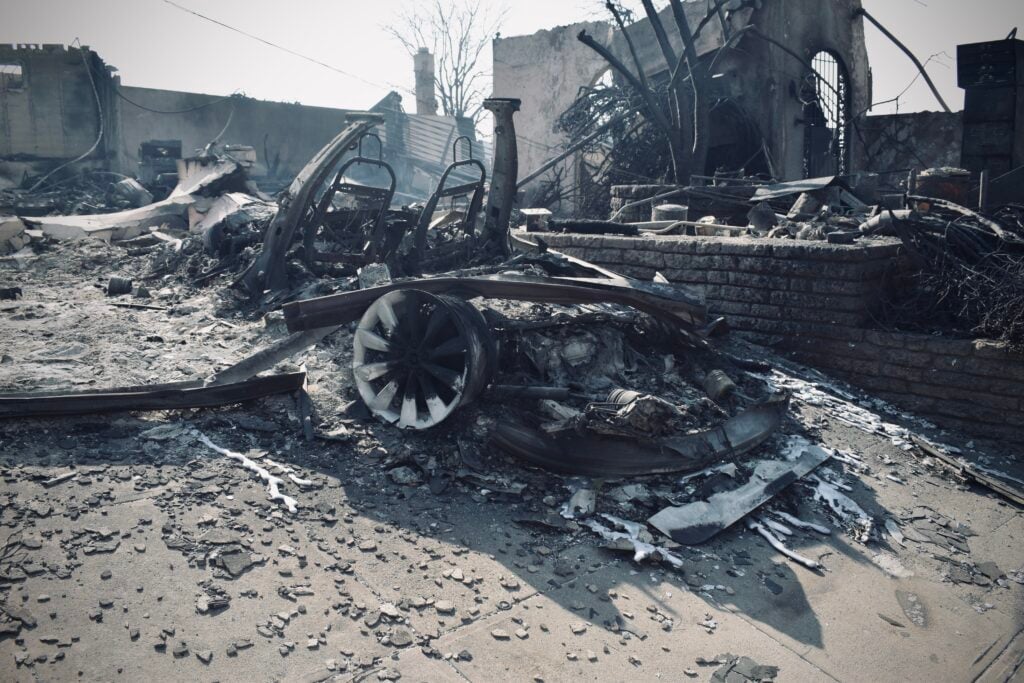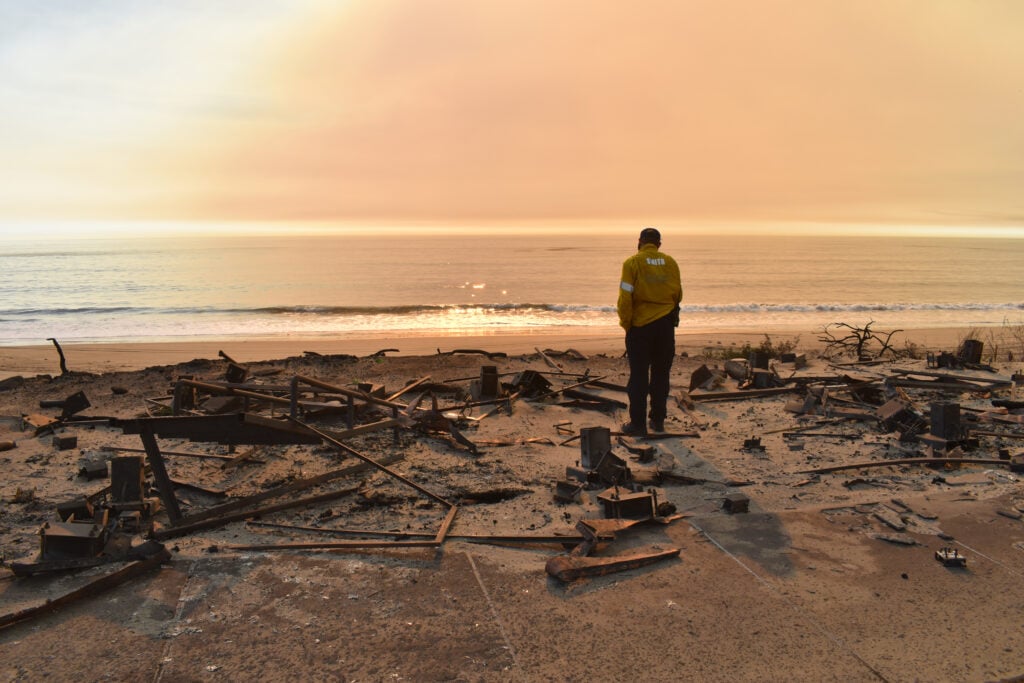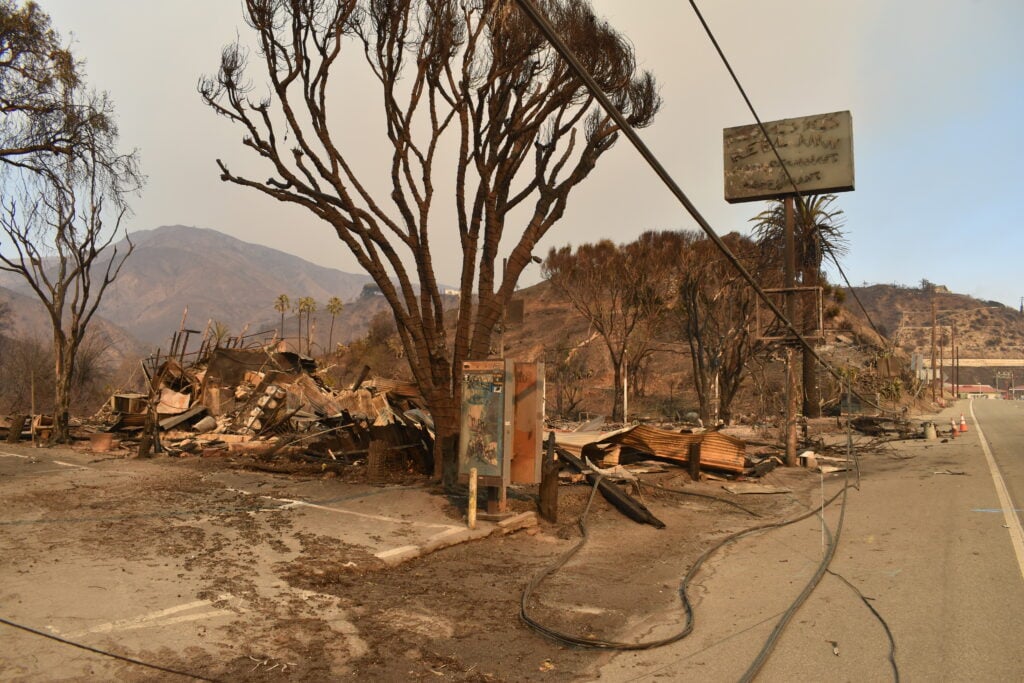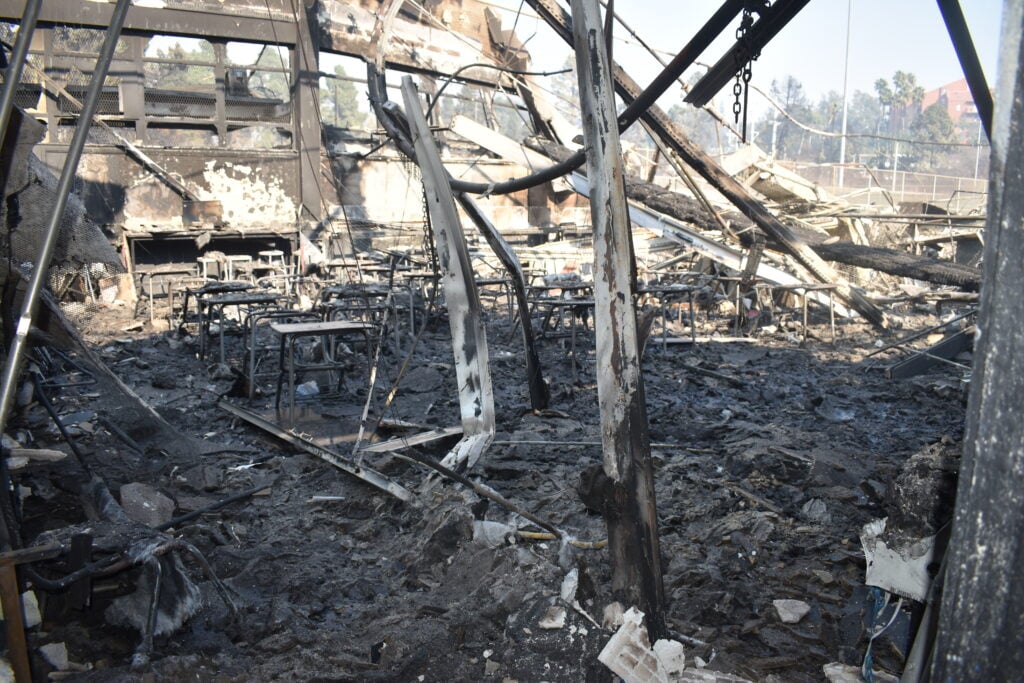Unlike actual property that can have a dollar value attached to it, the emotional cost to those who have lost everything cannot possibly be calculated. Photographs taken by news helicopters that have permission to fly in the Palisades airspace have been compared to those of Hiroshima on August 7, 1945. And in fact, earlier this week, Los Angeles County Sheriff Robert Luna said parts of the city looked like “an atomic bomb dropped.”
The Daily Press was granted access to walk around Palisades Village, which while not technically ground zero, certainly felt that way. Upon clearing a number of security checkpoints strategically placed along the eerily empty Pacific Coast Highway, it was necessary to turn into Temescal Canyon Road and it’s here that the first evidence can be seen in the form of abandoned and utterly incinerated cars.
Then, as you approach Palisades Village, the true extent of the damage begins to become apparent. Turning right onto Sunset Blvd, the sight of the utterly burnt out Shell gas station strikes you like a slap to the face. The Gelsons opposite, while only partially destroyed, still looks like a 2,000 lbs bomb has been dropped on it.
Maintenance crews could be seen working on downed power lines, some of which dangled precariously across the roads at about head height. Then, turning left into the residential Via De La Paz, the full extent of the horror came into focus as I passed one decimated residence after another.
To call the experience surreal doesn’t even begin to cover it. This particular Thursday morning was beautiful; it was still early, somewhere around half-past nine and there wasn’t a cloud in the sky. The massive, towing plumes of smoke we’d all seen on Tuesday and Wednesday were no longer visible and the only sound that could be heard was the gentle trickle of water, like a mountain stream flowing past, as fractured pipes continued to pour forth as if they were fountain features in a garden pond.

This soothing sound offered a strange calm as every other sense struggled to comprehend the post-apocalyptic landscape that seemed to stretch on and on, street after street in every direction. The tranquility was only broken every now and again as the two CL-415 "Super Scooper" firefighting planes flew overhead in their relentless attempts to suppress the fires from the air.
Black shells of burnt out cars littered the roadside and pools of once-molten metal have accumulated nearby. And everything is grey. There’s so much grey. Ash covered just about everything in sight and little was recognizable of the homes that were once here. Perhaps a brick chimney still stood, albeit scorched, but everything else was just a pile of grey rubble with the occasional sculpture of twisted metal that offered little explanation as to what it was before it burned.
Still-smouldering fires at first caused a little concern, but as residents began to return to their homes for the very first time, no one else seemed to be particularly worried. Some were coming back to the scene of the crime to see if by some miracle their house had survived and others were here to take photographs for the insurance companies.
The first resident I met was a gentleman named Tom Hershaw and I asked what the status of his home was. “It’s gone. All gone,” he said, losing the battle to fight back tears. At which point, I felt like someone had swung a sledgehammer into my stomach. Stepping through the aftermath was one thing, actually speaking with someone who had lost their home and everything in it, was something entirely new and more upsetting than I could’ve imagined.
“We were lucky, because my son is at St Matthews and the fire started right above that. And so at ten-thirty we got the notice to get the kids. I was at work in the valley, my wife was at work and our nanny was here,” Hershaw said.

“At that time, they weren't even evacuating, but she saw the smoke and she went to get both kids and that's when all the chaos happened. I came back and it was full-on crazy. The cops let me take my dog and that was it. So we have two cars, thankfully and these clothes and that’s about it. But we’re all safe.”
As the morning passed, it seemed more residents were seizing this opportunity to return to the scene of devastation. One couple were accompanied by two firefighters armed with a crowbar and pick axe who were attempting to open a fireproof safe, which despite having taken a beating, was largely intact. However, the firefighters stressed that there were no guarantees.
Another resident who had returned for the first time, Gail McMahon, spoke about her insurance concerns. “I don’t know how they’re going to handle it,” she said, adding, “I really don't have confidence, because they're going to find a way to underpay, right, for sure, the equity, they don't give a shit about it … I don't know what the fine print is, I don’t think many do.”
A gentleman who asked to be referred to as Sean said, “You always think it's never going to happen to you until it does. It did and we were caught with our pants down, we were not prepared.”
“It's going to be five years, or more, before it starts resembling what it was. But I just hope that people take this opportunity to build it back smarter, you know. And I hope that the government helps us to make this infrastructure more fire resilient,” he said.

Heading north on the PCH, I wanted to see what was left of the Reel Inn, a favorite fish-themed eatery. Part of its charm was that unique, Malibu “surf shack” aesthetic and tragically that probably didn’t help very much when confronted by a raging inferno. There was absolutely nothing left, aside from a pile of twisted and blackened corrugated metal sheets. Stepping over the rubble, all that was recognizable were a few burnt outdoor heaters and that was all.
Speeding back to Santa Monica along the empty highway, the sight of the utterly destroyed Pacific Palisades Bowl Mobile Estates caused me to stop to take photographs. And it was here that I met former residents Rachel McDonald, John Bouton and Jeff Garris. They told me that there were once 170 units there and this was the first time they’d returned.
“We're still in shock. I mean, we finally got up here today to, well, you just want to actually see it. You want to see the dead body, smell the dead body. Metaphorically speaking. It's kind of crazy,” McDonald said.
They reassured me that the community was close and everyone was sticking together. “Oh yeah, we have a great community and we're staying in contact. We're going to get through this and rise from the ashes and we'll, hopefully, be able to rebuild. Insurance isn't great on these and I would say half of the people have insurance, so it's a loss, but they say FEMA will help and all that. So, we’re hoping,” Bouton said.
Like so many others I’d met slowly making their way back into town, they asked me if I was heading back into Santa Monica since they no longer had a vehicle and had travelled all the way out here on rented e-bikes. Fortunately, this time I was, so in somewhat comical fashion, all three shoehorned themselves into my two-door Jeep and off we went.

Asking what was next for them, Bouton laughed, “A shower,” he said, adding, “And to buy underwear and socks.” For they too were only in possession of the clothes they’d been wearing when they had to evacuate and little more.
Much like many in Santa Monica, at first there was no significant fear, but come Tuesday evening, it’s safe to say I was getting nervous. Living only three blocks outside the Evacuation Warning Zone, panic entered my mind about how much I could actually take with me. Would my vintage comic collection fit in the car? What about my first editions and autographed novels? None of these are replaceable. And I wasn’t even in the Mandatory Evacuation Zone. Have I let material possessions take over my life? Where does one draw the line?
Now I’ve met and spoken to many who have lost everything they cherish and all they possess are the clothes they were wearing when they were forced to evacuate, to say it’s a sobering experience is an understatement.
And as if this isn’t enough, once the initial shock has passed there is a whole new set of nightmares to face, including insurance claims and rebuilding. Think about it, a whole community has to be rebuilt from scratch. The construction alone will be on an unprecedented scale. And before all of that, we are still very much at the mercy of Mother Nature. Will the dry spell continue and for how long? And when the rainfall does come, as it eventually will, is there a danger of mud slides now all the vegetation holding the hills together is gone?
The Great Fire of ‘25 is being called the worst wildfire in the history of Los Angeles and you could argue that we are having our 9/11 or Hurricane Katrina moment. Hopefully, the city and county will unite and rebound, just like both New Orleans and New York City did. And while – thankfully – the toll in human lives is no way near as many, the sheer scale of destruction is unquestionably far worse.
scott.snowden@smdp.com








